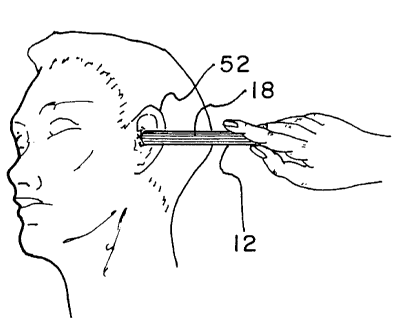Some of the information on this Web page has been provided by external sources. The Government of Canada is not responsible for the accuracy, reliability or currency of the information supplied by external sources. Users wishing to rely upon this information should consult directly with the source of the information. Content provided by external sources is not subject to official languages, privacy and accessibility requirements.
Any discrepancies in the text and image of the Claims and Abstract are due to differing posting times. Text of the Claims and Abstract are posted:
| (12) Patent: | (11) CA 2382698 |
|---|---|
| (54) English Title: | HAIR TRIMMING TOOL |
| (54) French Title: | TONDEUSE A POILS |
| Status: | Deemed expired |
| (51) International Patent Classification (IPC): |
|
|---|---|
| (72) Inventors : |
|
| (73) Owners : |
|
| (71) Applicants : |
|
| (74) Agent: | BORDEN LADNER GERVAIS LLP |
| (74) Associate agent: | |
| (45) Issued: | 2005-11-01 |
| (86) PCT Filing Date: | 2000-08-30 |
| (87) Open to Public Inspection: | 2001-03-08 |
| Examination requested: | 2002-05-23 |
| Availability of licence: | N/A |
| (25) Language of filing: | English |
| Patent Cooperation Treaty (PCT): | Yes |
|---|---|
| (86) PCT Filing Number: | PCT/US2000/023725 |
| (87) International Publication Number: | WO2001/015874 |
| (85) National Entry: | 2002-02-25 |
| (30) Application Priority Data: | ||||||
|---|---|---|---|---|---|---|
|
A hair trimming tool which includes
an elongated handle (12) with a first end (14) and
a second end (16), a blade member (20) releasably
mounted to the handle (12), a plurality of blades (26,
28, 30, 32, 34, 36, 38, 40) extending outwardly from
the blade member (20), and an end cap (46) secured
to the blade member (20) is disclosed. In order to
use the tool the user inserts the tool into his ear (52),
with the end cap (46) fitting within the ear (52), and
rotates the handle member (12). As a result of this
action the blades (26, 28, 30, 32, 34, 36, 38, 40)
contact the hair within the ear, thereby trimming the hair.
The end cap (46) protects the inside of the person's
ear while the hair is being trimmed.
Une tondeuse à poils comprend un manche allongé (12) doté de première (14) et deuxième (16) extrémités, un élément (20) à lames monté de manière amovible sur le manche (12), une pluralité de lames (26, 28, 30, 32, 34, 36, 38, 40) qui sortent à l'extérieur de l'élément (20) et un capuchon terminal (46) fixé sur l'élément (20). Lorsque l'utilisateur utilise la tondeuse il l'introduit dans son oreille (52), le capuchon terminal (46) se logeant dans l'oreille (52) et il fait tourner le manche (12). Il résulte de cette action que les lames (26, 28, 30, 32, 34, 36, 38, 40) se trouvent en contact avec les poils présents dans l'oreille et peuvent ainsi les couper. Le capuchon terminal (46) protège la zone interne de l'oreille de la personne lorsque les poils sont coupés.
Note: Claims are shown in the official language in which they were submitted.
Note: Descriptions are shown in the official language in which they were submitted.

For a clearer understanding of the status of the application/patent presented on this page, the site Disclaimer , as well as the definitions for Patent , Administrative Status , Maintenance Fee and Payment History should be consulted.
| Title | Date |
|---|---|
| Forecasted Issue Date | 2005-11-01 |
| (86) PCT Filing Date | 2000-08-30 |
| (87) PCT Publication Date | 2001-03-08 |
| (85) National Entry | 2002-02-25 |
| Examination Requested | 2002-05-23 |
| (45) Issued | 2005-11-01 |
| Deemed Expired | 2008-09-02 |
There is no abandonment history.
| Fee Type | Anniversary Year | Due Date | Amount Paid | Paid Date |
|---|---|---|---|---|
| Application Fee | $150.00 | 2002-02-25 | ||
| Request for Examination | $200.00 | 2002-05-23 | ||
| Maintenance Fee - Application - New Act | 2 | 2002-08-30 | $50.00 | 2002-08-01 |
| Maintenance Fee - Application - New Act | 3 | 2003-09-01 | $50.00 | 2003-07-30 |
| Maintenance Fee - Application - New Act | 4 | 2004-08-30 | $50.00 | 2004-07-16 |
| Final Fee | $150.00 | 2005-07-21 | ||
| Maintenance Fee - Application - New Act | 5 | 2005-08-30 | $100.00 | 2005-08-10 |
| Maintenance Fee - Patent - New Act | 6 | 2006-08-30 | $100.00 | 2006-08-30 |
Note: Records showing the ownership history in alphabetical order.
| Current Owners on Record |
|---|
| PINO, ROBERT F. |
| Past Owners on Record |
|---|
| None |